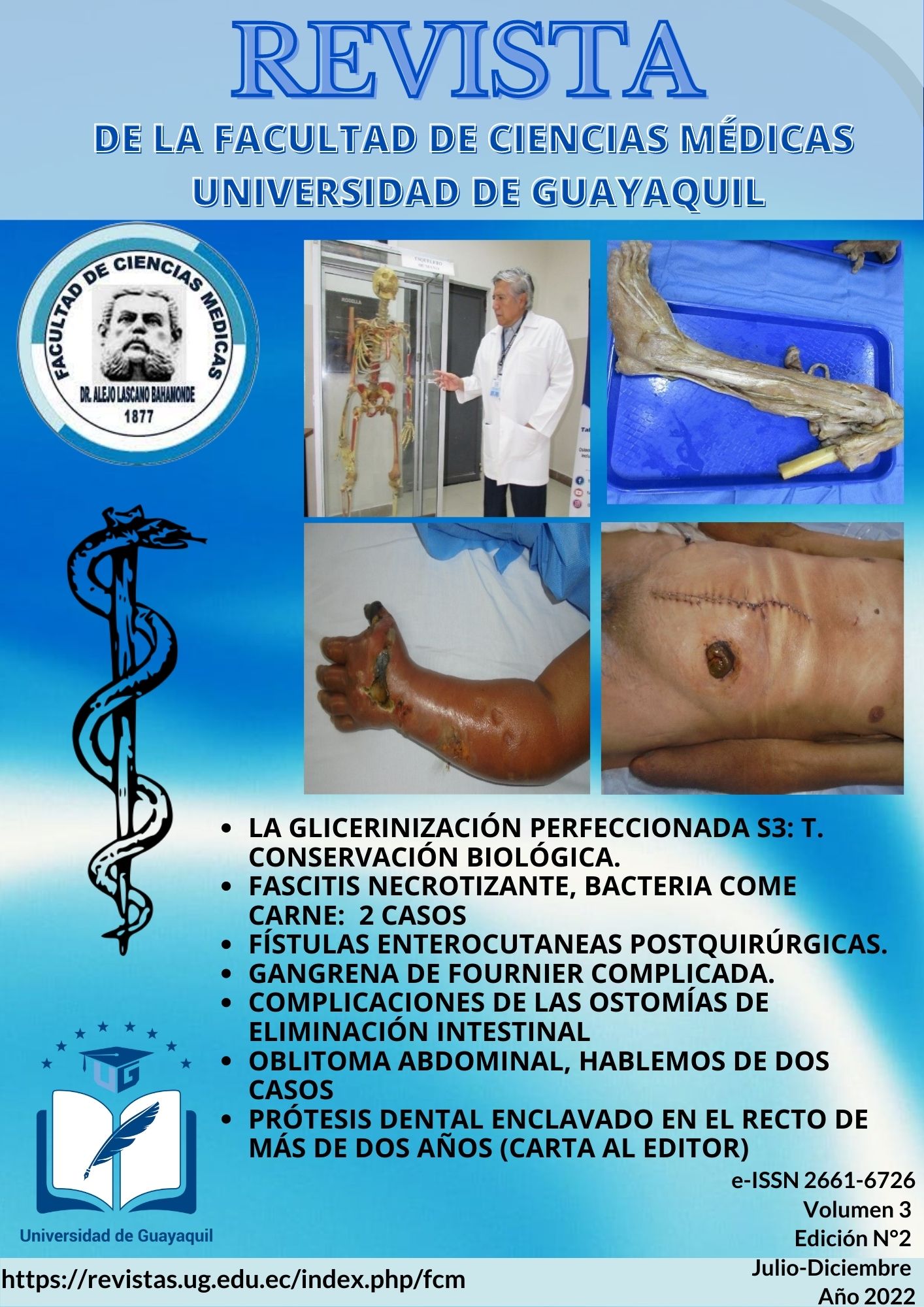Post-surgical enterocutaneous fistulas, risk factors and complications in the Guayaquil hospital. January 2010 to December 2014.
Keywords:
fistulas, complications, risk factorsAbstract
The worldwide prevalence of this pathology varies from <10%, depending on the region, type of surgery performed, type of injury, composition (sex, age, race and ethnicity, etc.) of the population studied and the final result is peritonitis. diffuse and sepsis with mortality ranging between 1% and 15%. Its most common etiology is postoperative. In 80-90% of emergency surgeries, it tends to present an overall mortality rate of up to 15-25%, with reports of spontaneous closure in up to 80% of patients who have received clinical treatment using parenteral nutrition.
Of the total sample studied (100 patients), 40% corresponded to the highest number of admissions in 2010. Of the total sample studied (100 patients), 44% corresponded to the age group between 41 and 60 years , the mean age was 48.35 years. . Of the total of the studied sample that presented risk factors (73 patients), alcoholism is indicated more frequently in 36%, followed by malnutrition in 27%, smoking with 8%, drug addiction with 7%, HIV infection with 7%(5), intra-abdominal CA with 5%(4), lung Ca with 4%, thyroid Ca with 3%(2) and Leukemia with 3%.
Of the total sample studied (23 patients), 30% corresponded to the one with the highest type of complications, peritonitis and intra-abdominal abscess, respectively.
References
Department of surgery Washington University School of Medicine. The Phistula. Washington: 2012, Arm J Surg, Vol. 127(2), págs. 122-7.
Mizrahi, Solly. Postoperative intestinal anastomotic leak and enterocutaneous fistula. s.l. : Elsevier Saunders, 2014. Vol. 3.
World Gastroenterol. Gastric leaks post sleeve gastrectomy: Review of its prevention and management. 2014, World J Gastroenterol, págs. 20-38.
Schecter, WP. Management of enterocutaneous fistulas. Jun de 2011, Surg Clin NorthAm, Vol. 91, págs. 481-91.
Moncayo, Fernando. El Abdomen de emergencia. Guayaquil : EduQuil, 2014. págs. 118-127.
Campos AC, Andrade DF, Campos GM, Matias JE, Coelho JC. A multivariate model to determine prognostic factors in gastrointestinal fistulas. May de 1999, J Am Coll Surg, Vol. 188(5), págs. 483-90.
Us de Paz, Gustavo. Perfil epidemiológico. clínico y terapéuticos de las Fístulas Enterocutáneas. Hospital Roosevelt, Guatemala C.A 2008-2010. Facultad de Ciencias Médicas. Unidad de Tesis, Universidad de San Carlos de Guatemala. 2010.
Arezzo A, Verra M, Reddavid R, Cravero F, Bonino MA, Morino M. Efficacy of the over the-scope clip (OTSC) for treatment of colorectal postsurgical leaks andfistulas.2010, Surg Endosc, Vol. 11(1).
Department of surgery Washington University School of Medicine. Manual Washington de Cirugía. Philadephia : Lippincott Williams & Wilkins, 2012.
Fiorelli A, et al. Large tracheobronchial fistula due to esophageal stent migration: Let it be! 4 de Jun de 2015, Asian Cardiovasc Thorac Ann. pii: 0218492315587816..
Galván, W. Fistulas adquiridas. 1, 2009, Arm J Surg, Vol. 3.
Graif A, Conde K, DeMauro CA. Imaging of a gastrobronchial fistula after gastricbypass surgery and the contrast dilemma. Apr de 2015, Del Med J. 2015:113-6., Vol. 87(4).
Raman S, Pokala N, Cosgrove J, Jamil Z. Colocutaneous fistula after suction lipoplasty: case report and literature review. Apr de 2010, Ann Plast Surg, Vol. 64(4), págs. 503-5.
Hahler B, Schassberger D, Novakovic R, Lang S. Managing complex, high-output, enterocutaneous fistulas: a case study. 15 de Oct de 2009, Ostomy Wound Manage, Vol. 10(1), págs. 30-42.
Hardin M, et al. Experience in the management of the open abdomen in severely injured burn patients. Jul de 2012- Aug, J Burn Care Res, Vol. 33(4), págs. 491-6.
Karson, M. Necrotizing fasciitis secondary to enterocutaneous fistula: Three case reports. 24, Jun de 2014 , World J Gastroenterol , Vol. 20, págs. 7988-7992.
Kirshtein B, Mizrahi S. Vacuum-assisted management of enteroatmospheric fistula within the open abdomen. Feb de 2014, Am Surg, Vol. 80(2), págs. 209-10.
Kolbel M. Factores asociados a la dehiscencia clínica de una anastomosis intestinal grapada. 1 de Jun de 2006, Revista Chilena de Cirugía, Vol. 13(1).
Layton B, Dubose J, Nichols S, Connaughton J, Jones T, Pratt J. Pacifying the open abdomen with concomitant intestinal fistula: a novel approach. Apr de 2010, Am J Surg, Vol. 199(4), págs. e48-50.
Marinis A, et al. Enteroatmospheric fistulae"--gastrointestinal openings in the open abdomen: a review and recent proposal of a surgical technique. 2013, Scand J Surg, Vol.102(2), págs. 61-8.
Ravindran P, et al. Definitive surgical closure of enterocutaneous fistula: outcome and factors predictive of increased postoperative morbidity. 2013, Colorectal Disease, Vol. 12(1), págs. 209-218.
Rubin, R et al. Pathology: Clinicopathologic Foundations of medicine. 6ª edición. Philadelphia : Lippincott Williams & Wilkins, 2012.
Shirish K Bhansali, SC Shah. Enterocutaneous Fistula. 2010, Recent Advances in Surger, Vol. 10(1), págs. 282- 290.
Terzi C, Egeli T, Canda AE, Arslan NC. Management of enteroatmospheric fistulae. Jun de 2014, Int Wound J, Vol. 11(1), págs. 17-21.





